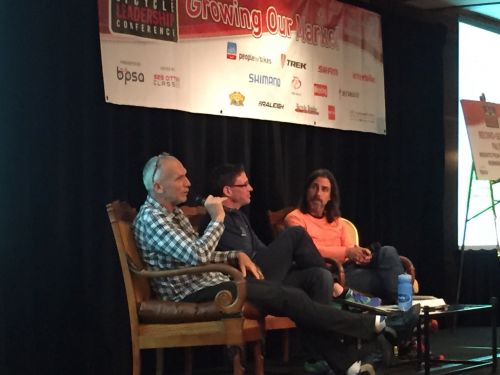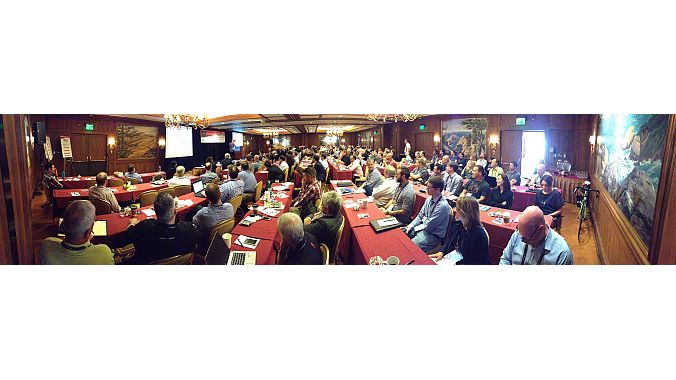MONTEREY, Calif. (BRAIN) — With 5 percent growth in overall participation in 2013 and sales growth hitting double and single digits since 2010, the running market has stemmed recent sales and participation declines seen in other sports including biking and golf.
A panel representing the supply, retail and consumer channels for running told attendees at the Bicycle Leadership Conference Wednesday that stakeholders have worked to cultivate new runners, bring more women into the fold, embrace nontraditional run events, move away from timed races and expand time limits on competitive events. The end goal: remove barriers and make running more inclusive.
"The sport of running has torn down the wall of intimidation in recent years," said Bart Yasso, chief running officer of Runner's World magazine.
Yasso, who's been running since the 1970s, completed more than 100 endurance races and biked unsupported across the country twice, acknowledged that events like the Color Run, the Spartan races and others have had a major impact on taking the sport beyond the elite running athlete to the masses.
Obstacle races drew 4 million participants in 2013, surpassing both half marathons and marathons, which have a combined participation of 2.5 million.
"The median time for completing a marathon is four hours and 25 minutes," Yasso said, about an hour longer than in the sport's earlier days. "That's changed tremendously. The sport was willing to do it. There were no geniuses at the wheel. It happened organically."
Yasso himself participated in an Amish running event that has grown from four runners to 400 in four years. He said diversity is a key issue both in the bike and running industry—not only of gender but race and athletic ability. The running industry long ago welcomed wheelchair competitors in races, for example.
Events like wine country races where participants are treated to wine following a 5K, 10K or half marathon have been a boon for bringing in more women, he said.
Mike Cosentino, owner of Big Peach Running Co., a specialty retailer with seven stores throughout the Atlanta metro region, puts his own spin on fun runs holding three-mile pub runs and scavenger hunts. "I love the Color Run and Rock and Roll marathon, but more importantly I like the Tuesday night pub run we have every week at our Decatur store or the scavenger hunt we can do once a quarter," he told attendees.
Women have been at the core of the growth in the sport. Women have gone from being 11 percent of all marathon finishers in 1980 to 42 percent in 2012. In 2010 women surpassed men as running event finishers, according to Jessica Klodnicki, executive vice president and general manager of Bell and Blackburn, who moderated the panel and presented a flurry of statistics that showed the upward trend of the sport. Before her role at BRG Sports, Klodnicki was an executive at Mizuno USA, a brand entrenched in several sports including running.
Rick Wilhelm, vice president of executive sales for Brooks Running Company, noted that 60 percent of Brooks' sales are to women despite not having a women's-specific shoe last. But he said key to attracting newcomers — as well as women — is to get rid of the technical jargon that clouds the marketing message of "fun." Wilhelm, who looked into reserving a bike to ride during the conference here in Monterey, said he was confused by all the specs and technical speak he found when looking up what bike to get on the conference website.
"That's shop talk not cyclist talk, as I view it," he said. "I just wanted two wheels and something that wouldn't make me fall down."
He acknowledged that while the barriers of entry are low even at the high end of the running product segment—with running shoes costing around $100 to $150 on average compared to a bike that can easily be in the thousands — retailers must still make sure to address the needs of customers and connect with them.
"From Brooks' point of view we try to make it fun," he added. "Running is very social. Even though we distribute to other channels (besides specialty), because it's so social runners will keep coming to brick-and-mortar stores because they want to talk about themselves. Everyone has a good story."
And while making it accessible, fun and diverse has helped grow participation and ultimately sales, specialty running retailers haven't been immune to the competitive pressures of big box and online shopping. But Big Peach's Cosentino noted that he's focused on aspects such as convenience and customer experience in his stores — two areas where he feels he can come out on top.
"These pressures have always been there," Big Peach's Cosentino said. "We are mindful of areas we can win and spend less time griping about competitive pressures because most of the time that's synonymous with trying to win on price.
"This is about retail not about cycling, snowboarding or other interests," he said, adding that stores must pay attention to fundamental retail principles like boosting store traffic, upping their conversion rate of traffic to sales, increasing customer frequency and transaction size.
Brooks' Wilhelm said the company trimmed its distribution — "anybody who had a pulse we sold to" — and stopped selling directly to Amazon. It also closely polices its unilateral MAP policy and makes sure to never be out of "core" product — all efforts to grow profitability, be easy to do business with and maintain a vibrant specialty channel.







